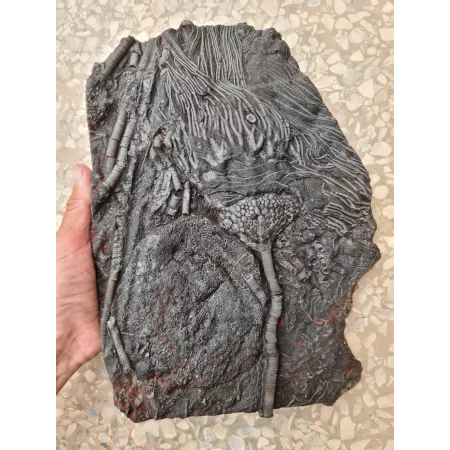Crinoid - Fossilized Marine Creature | Ancient Evolutionary History

Crinoid
Structure and Appearance:
Fossil crinoids come in various forms, but many have a plant-like appearance. They consist of a calcareous stem or "column" attached to the seafloor, from which radiate branched arms. These arms were used to capture food particles from the water.
Size:
Fossil crinoids could vary greatly in size, ranging from a few centimeters to several meters in length for some species.
Location:
Crinoids were abundant in ancient seas, primarily inhabiting shallow waters. Their fossilized remains are often found in sedimentary rocks formed from marine deposits.
Composition:
The most commonly fossilized parts of crinoids are their calcareous ossicles, which formed the stem and arms. These structures are often well-preserved in fossiliferous rocks.
Lifestyle:
Crinoids were typically sessile organisms, attached to the seafloor by their column. Some were mobile during their juvenile stage, but many adult crinoids remained fixed in one spot throughout their lives.
Evolution:
Crinoids have a long evolutionary history dating back millions of years. They are fascinating creatures that provide valuable insights into marine life during the Paleozoic Era.
Crinoid - Discover the Enigmatic Fossils
Explore the fascinating world of Crinoids, ancient marine creatures with an evolutionary history dating back over 500 million years. These enigmatic creatures have intrigued scientists for centuries, offering insights into the prehistoric oceans and ecosystems they inhabited.
Despite undergoing numerous changes over millions of years, Crinoids retained some fundamental anatomical features that remained relatively unchanged. These unique characteristics have enabled paleontologists to trace the evolution of Crinoids through various geological ages, providing invaluable data for understanding the biodiversity and environmental shifts of ancient times.
Immerse yourself in the world of Crinoids and marvel at their intricate fossilized remains that have survived the test of time. From their delicate branching structures to their intricate feeding mechanisms, Crinoids offer a glimpse into a bygone era when these graceful creatures thrived in the primordial seas.
